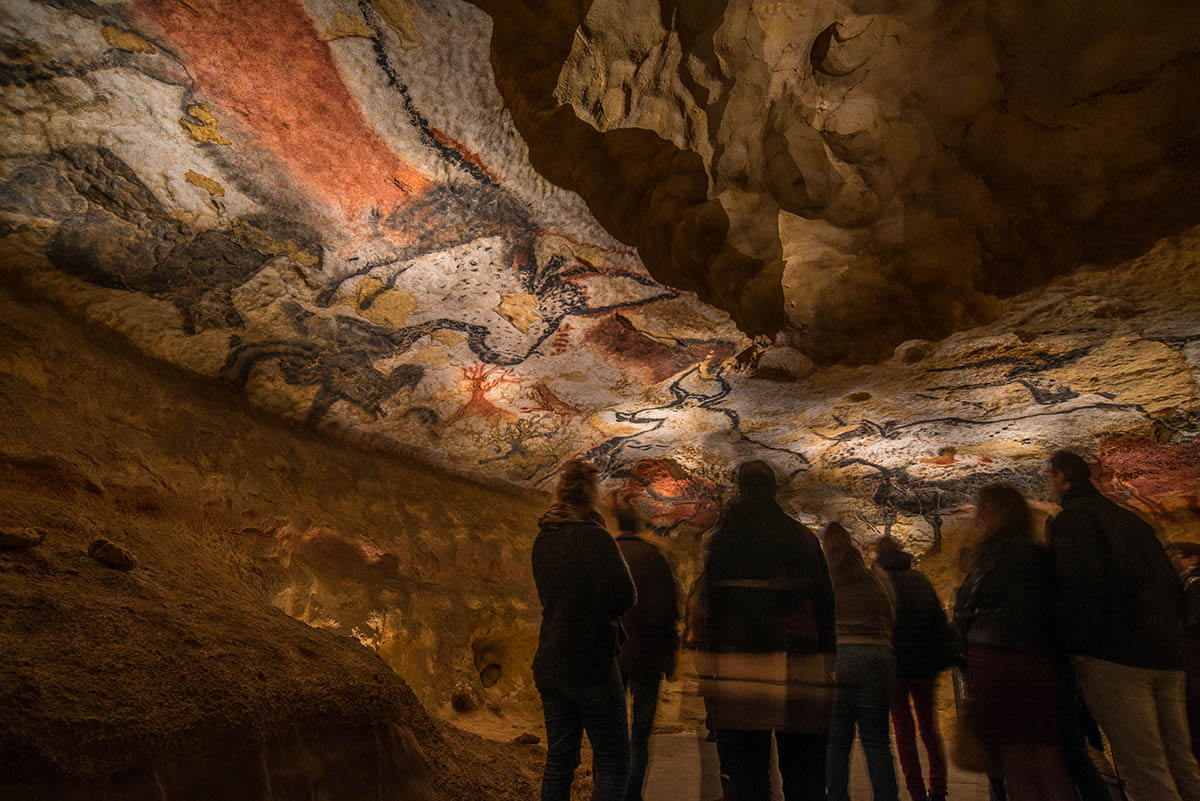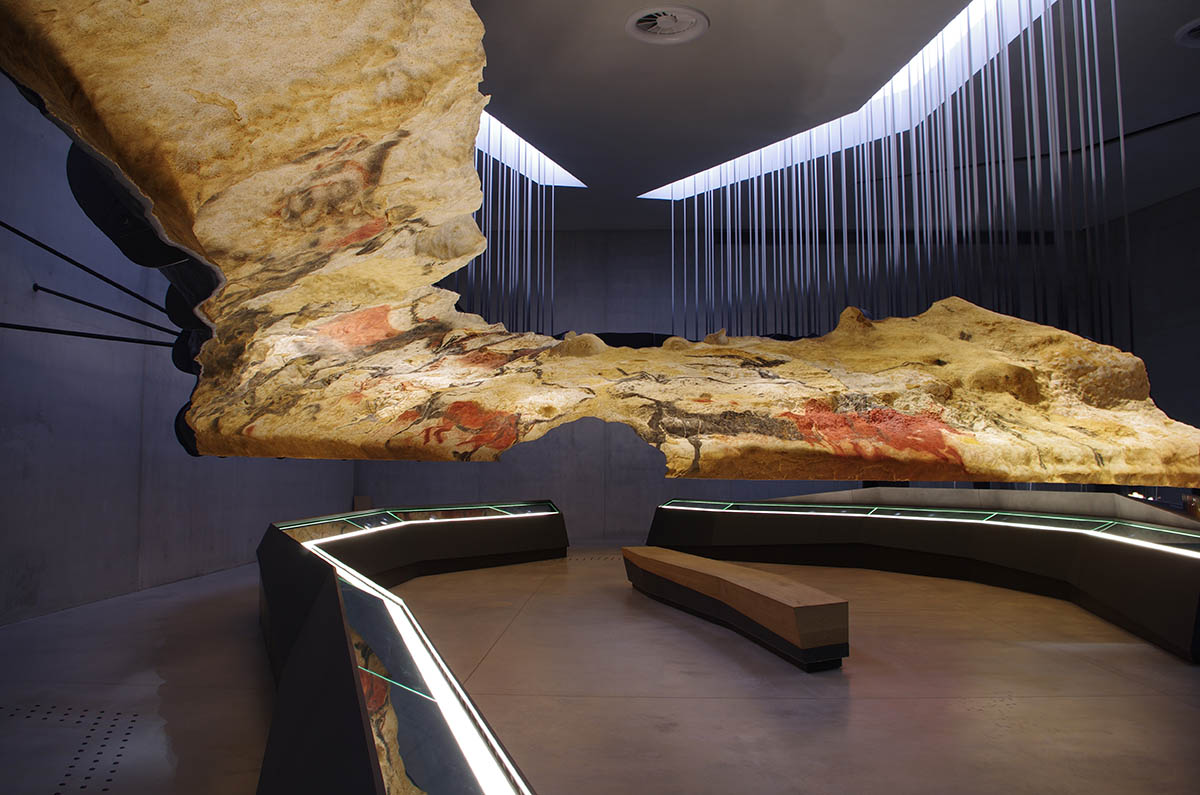Submitted by WA Contents
Snøhetta’s snake-shaped Lascaux IV Caves Museum opened in France
France Architecture News - Apr 03, 2017 - 10:08 18542 views

These photographs offer in-depth look at inside and outside of the Lascaux IV Caves Museum in Montignac, France designed by Norwegian firm Snøhetta in collaboration with SRA Architectes and Duncan Lewis Scape Architecture alongside scenographer Casson Mann, worked closely with a team of archaeologists to create a holistic museum and educational experience.
The new International Centre for Cave Art (Centre International d’Art Parietal) in Montignac, France has officially opened its doors to visitors on Friday with an immersive educational experience of the prehistoric Lascaux cave paintings.

Image © Luc Boegly + Sergio Grazia
The Lascaux IV Caves Museum features the 20,000-year-old paintings which are known as the finest examples of art from the Paleolithic period- revealed by archaeologists as the 'Sistine Chapel of Prehistory' due to their spiritual and historical significance.
Encompassing a total of 8,365 square-metre floor space, the building is stretched out along the edge of an agricultural territory marked by human activity and a thick forest whose dense and tall vegetation plunges the undergrowth into the shade.

Image © Luc Boegly + Sergio Grazia
Snøhetta and SRA Architectes designed an interpretation center featuring state-of-the-art experiential storytelling technology paired with a facsimile of the caves.
Inside the museum, visitors discover the caves in a unique way that reveals a sense of wonder and mystery, as if they, too, were the first group of adventurers to stumble upon the cave paintings.

Image © Luc Boegly + Sergio Grazia
The Lascaux IV Caves Museum is located on the border of the Vézère valley and the Lascaux hill. The Vézère valley in Dordogne, France, is conceived as a mecca of prehistory.
The site contains about 15 major sites, all on the UNESCO World Heritage List. The Lascaux cave has one of the most important groups of Paleolithic rock wall art, both by its number and by the exceptional quality of its works.

Image © Luc Boegly + Sergio Grazia
''By framing the experience of the cave replica in contemporary design, the approach counters the potential trap of artifice: the materiality and geometry of the approach allows the visitor to understand that they are in the presence of a reproduction, without distracting from the power of its impact,'' said Snøhetta.
''The form and materiality of the museum have a monolithic, sober expression, speaking to the surrounding nature and the massive rock formations embedded in the hill, with a new public, agricultural landscape unfolding around it.''

Image © Luc Boegly + Sergio Grazia
A visitor experience is carefully sequenced. Beginning in the lobby, visitors ascend by a lift to the belvedere out on the roof, where they can enjoy a magnificent panoramic view of Montignac and the Vézère Valley.

Image © Luc Boegly + Sergio Grazia
They then descend a gentle slope towards the cave facsimile, which follows the incline of the roof towards the edge of the forest until reaching the entrance to the replica.
The winding path through the landscape and gradual descent back down to grade facilitates a mental transition through time and space, creating an experience similar to that of the cave’s first discoverers in 1940.

Image © Eric Sole
Inside the cave facsimile, the atmosphere is damp and dark, re-creating the humidity within the caves. Sounds are muffled; the temperature drops to about 16 degrees Celsius.

Image © Luc Boegly + Sergio Grazia
This sequence is dedicated to contemplation, allowing people an experience of the sanctuary that once was. Lights flicker just as the animal fat lamps of Paleolithic times did, revealing the layers of paintings and engravings on the surface of the walls.

Image © Luc Boegly + Sergio Grazia
The interpretive center that follows provides interactive exhibitions to teach the rich history of the Vézère Valley and cave paintings. Casson Mann’s installations are enhanced by digital learning experiences, employing new technological devices and interactive screens to offer the findings of the most recent research from expert pre-historians and archaeologists.

Image © Dan Courtice
Visitors can engage with a device known as the ‘Companion De Visite’ specially designed for the museum. The interactive digital companion device (CdV) liberates the gallery spaces from text panels – blending art, history, culture and contemplation by offering layers of additional information and views into the virtual reality of the past.

Image © Eric Sole
The first exhibition space in the interpretive center is The Workshop (L’Atelier de Lascaux), with 8 hanging rock wall fragments, where visitors can examine the paintings more closely.

Image © Luc Boegly + Sergio Grazia
This space also provides information on the history of the caves, their discovery, why the real cave is now closed, and how the artists of 20,000 years ago worked.

Image © Eric Sole
The Cave Art Theatre (Le theatre de l’art paretial) presents a three-act play using light, sound, movies and objects to give life to the story of Lascaux’s cave art. In the Cinema, visitors wear 3D stereoscopic glasses for a 3D film on a digital voyage through the cave.

Image © Eric Sole
In the Imagination Gallery, (La galerie de l’imaginaire), visitors are able to explore the influence of prehistoric cave art on modern and contemporary artists. This content has been curated by John Paul Jouary, professor, philosopher and author, whose work is devoted to the relationship between Paleolithic art and the art of our time.

Image © Luc Boegly + Sergio Grazia
As a striking, contemporary addition to the landscape of the Vezere Valley, Lascaux IV frames a new experience of some of the finest known examples of prehistoric art, and offers profound new ways of understanding the rich heritage of its site.

Image © Eric Sole
The project is forged of a combination of low-tech and high-tech elements, from the meticulously hand-painted replica to virtual-reality exhibitions, engaging its visitors in a contemporary (re)discovery of the art of our ancestors.

Image © Luc Boegly + Sergio Grazia
Weaving together physical and interpretive concepts and spaces, the holistically conceived center unites Paleolithic art with contemporary approaches to spatial and experiential storytelling.

Image © Luc Boegly + Sergio Grazia
Snøhetta recently completed a soaring mirrored- cabin in Sweden and a rippling-stainless steel expansion to Lillehammer Art Museum and Lillehammer Cinema in Norway. Snøhetta is currently working on the King Abdulaziz Centre for World Culture, which nears completion in Dhahran, Saudi Arabia.
The firm is currently working on a checkered-looking Banque Libano Francaise headquarters in Beirut.
> via Snøhetta
